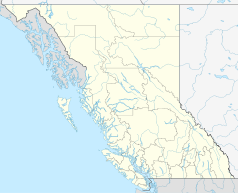Port Moody
| Port Moody | ||
|---|---|---|
 Port Moody Town Hall |
||
| Location in British Columbia | ||
|
|
||
| State : |
|
|
| Province : | British Columbia | |
| Regional District : | Metro Vancouver | |
| Coordinates : | 49 ° 17 ′ N , 122 ° 50 ′ W | |
| Height : | 40 m | |
| Area : | 25.89 km² | |
| Residents : | 33,551 (as of 2016) | |
| Population density : | 1,295.9 inhabitants / km² | |
| Time zone : | Pacific Time ( UTC − 8 ) | |
| Postal code : | V3H | |
| Foundation : | 1913 (incorporated) | |
| Mayor : | Mike Clay | |
 Location in the Metro Vancouver area |
||
| Port Moody Glenayre | ||||||||||||||||||||||||||||||||||||||||||||||||
|---|---|---|---|---|---|---|---|---|---|---|---|---|---|---|---|---|---|---|---|---|---|---|---|---|---|---|---|---|---|---|---|---|---|---|---|---|---|---|---|---|---|---|---|---|---|---|---|---|
| Climate diagram | ||||||||||||||||||||||||||||||||||||||||||||||||
| ||||||||||||||||||||||||||||||||||||||||||||||||
Port Moody is a city in the southwest of the Canadian province of British Columbia . It is located around 20 km east of Vancouver and belongs to the Metro Vancouver district .
Was named the city after Richard Clement Moody , who from 1858 to 1863, the first vice-governor ( English lieutenant governor ) of the colony of British Columbia was.
geography
Port Moody lies at the end of Burrard Inlet , a fjord that formed during the last glacial period and runs from west to east . Most of the western part of the municipality is forested and borders the Indian Arm , a branch of the Burrard Inlet that leads north. Eagle Mountain, a wooded ridge up to 1050 m high, also extends to the north. To the south and southeast lies the flat isthmus of the Burrard Peninsula .
Neighboring communities to Port Moody are Anmore to the north, Coquitlam to the east and south, Burnaby to the southwest, North Vancouver District to the west and Belcarra to the northwest.
history
The earliest residents were the Squamish and Musqueam , who had temporary camps in the summer where they hunted, fished, and gathered shellfish. The first Europeans, mostly fur traders , arrived in the area around 1800. During the Cariboo gold rush of 1858/59, a unit of Royal Engineers under the command of Richard Moody built a path to the eastern end of the fjord. In the event of a US attack, ships should land there and supply the city of New Westminster, a little further south on the Fraser River , with goods and drop off soldiers. A small settlement called Port Moody developed around the pier.
One of the conditions of British Columbia's accession to the Canadian Confederation in 1871 was the construction of a transcontinental railroad. In 1879 the Canadian Pacific Railway (CPR) set Port Moody as the western terminus of the route, and surveying work began two years later. As a result, the population grew rapidly and there was large-scale land speculation in the hope that Port Moody would develop into a major metropolis thanks to the railroad.
On November 7, 1885, the last nail was set in Craigellachie and the first train reached Port Moody the following day. Scheduled operations began on July 4, 1886. In the meantime, the CPR had decided to relocate the western terminus to Vancouver , where more space was available for port facilities. The real estate bubble burst and Port Moody performed much more slowly than expected. On April 7, 1913, Port Moody was declared a city.
Demographics
The census in 2016 showed a population of 33,551 inhabitants for the municipality, after the census in 2011 showed a population of 33,011 inhabitants for the municipality. The population increased by only 1.6% compared to the last census in 2011 and is thus far below the provincial average with a population increase in British Columbia of 5.6%. In the census period from 2006 to 2011, the population in the municipality had already increased by an above-average 19.9%, while the provincial average rose by 7.0%.
For the 2016 census, a median age of 40.6 years was determined for the municipality . The median age of the province in 2016 was 43.0 years. The mean age was 39.0 years, or 42.3 years in the province.
economy
In the past sawmills and processing industries were predominant, today the service sector dominates. The largest employer is Eagle Ridge Hospital with 900 employees. In addition, there is a for port Vancouver belonging loading facilities for bulk , two petrochemical plants and one geothermal power plant. In 2004 Port Moody declared itself the “City of Art” because of the high concentration of small businesses that are active in the cultural sector (film production, handicrafts, music) and several cultural festivals.
traffic
Port Moody is on Highway 7A, which runs from Vancouver to Hope via Burnaby and Maple Ridge . The city is located on the main route of the Canadian Pacific Railway , on which mainly freight traffic is handled. The West Coast Express local train runs on it . The city is also served by several bus routes operated by the Coast Mountain Bus Company . Port Moody is still connected to the Evergreen Line , a line of the driverless public transport system Sky Train . It runs from Burnaby via Port Moody to Coquitlam and was opened in 2016.
Web links
- Port Moody ( English, French ) In: The Canadian Encyclopedia .
- City administration
Individual evidence
- ^ Port Moody Community Profile. Census 2016. In: Statistics Canada . November 16, 2017, accessed March 27, 2018 .
- ^ Port Moody Community Profile. Census 2011. In: Statistics Canada . May 31, 2016, accessed March 27, 2018 .
